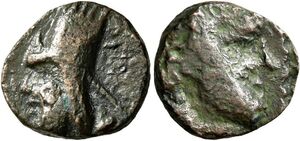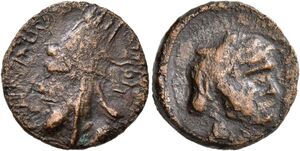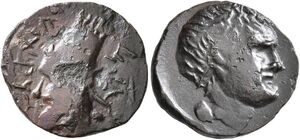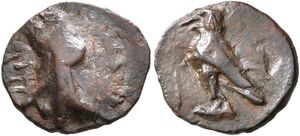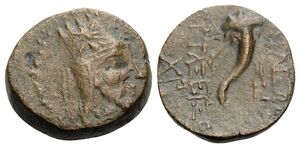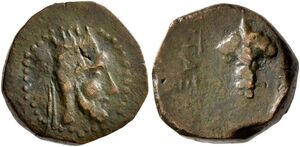Artaxias I c. 190-160 BC (Kov 37-48)
Description
The first of the Orontid kings to issue coins specifically for the Kingdom of Armenia Major was Artaxias I (BNP [1]) Artaxias had been appointed strategos, military governor, of Armenia Major under Antiochus III (223-187 BC), but after Antiochus's defeat in 190 BC at the Battle of Magnesia Artaxias declared his independence and assumed the title "king."
Artaxias once again became a Seleucid vassal after the invasion of Armenia in 165 BC by Antiochus IV. After the death of Antiochus in 164 BC Artaxias reasserted his independence, and threw his support to the Seleucid usurper, Timarchus. Timarchus prevailed in Media and Babylonia until his defeat at the hands of Demetrius 1(162-150 BC). Artaxias thereafter maintained the independence of Armenia, leaving it to his son, Artavasdes in 160 BC.
The coins of Artaxias I are of particular interest, aside from simply being the first coins of Armenia Major and only recently discovered. They also illustrate the transformation of the bashlyk to the upright tiara, which is perhaps the most recognizable symbol of ancient Armenian coin. Further, the coins of the reign of Artaxias I signal the emergence of a geographically peripheral province as an important kingdom after the Hellenistic model, and as a central player in the balance of power between Rome and the East.
His first coins, of rather rustic style, bear legends in Aramaic script ‘rthssy mlk "King Artashes" ("Artashes" = Greek "Artaxias") as found on his boundary stones marking land partitions. The headdress is a bashlyk with lappets and fanion, and a brim folded up over the forehead; the felt or leather body is drawn up and tied at the top, producing several peaks, recognizable as the first stage of the development of the Armenian tiara. In no. 44 the tiara is already more formalized, though still undecorated as far as one can see from the few examples known. The reverse type on the two chalkoi no. 37 is the bare head of a male (the Zoroastrian deity Verethragna ?) which is later replaced by a head with a diadem and small star above the forehead, likely Antiochus IV and thus issued in 165 BC. The remaining types, bee, eagle, and dog (probably an Armenian wolfhound, or gampr), seem to reference the resources of the mountainous kingdom.
After his initial coinage with Aramaic legends, Artaxias adopted a Hellenized coinage of much finer style employing Greek legends, and control marks. At this point a star is added to the tiara which has now assumed the more formal shape of all Armenian tiaras to follow.
Kovacs, Frank L. “Armenian Coinage in the Classical Period” CNS 10, Classical Numismatic Group, Lancaster, 2016, pp. 9.
Artaxias once again became a Seleucid vassal after the invasion of Armenia in 165 BC by Antiochus IV. After the death of Antiochus in 164 BC Artaxias reasserted his independence, and threw his support to the Seleucid usurper, Timarchus. Timarchus prevailed in Media and Babylonia until his defeat at the hands of Demetrius 1(162-150 BC). Artaxias thereafter maintained the independence of Armenia, leaving it to his son, Artavasdes in 160 BC.
The coins of Artaxias I are of particular interest, aside from simply being the first coins of Armenia Major and only recently discovered. They also illustrate the transformation of the bashlyk to the upright tiara, which is perhaps the most recognizable symbol of ancient Armenian coin. Further, the coins of the reign of Artaxias I signal the emergence of a geographically peripheral province as an important kingdom after the Hellenistic model, and as a central player in the balance of power between Rome and the East.
His first coins, of rather rustic style, bear legends in Aramaic script ‘rthssy mlk "King Artashes" ("Artashes" = Greek "Artaxias") as found on his boundary stones marking land partitions. The headdress is a bashlyk with lappets and fanion, and a brim folded up over the forehead; the felt or leather body is drawn up and tied at the top, producing several peaks, recognizable as the first stage of the development of the Armenian tiara. In no. 44 the tiara is already more formalized, though still undecorated as far as one can see from the few examples known. The reverse type on the two chalkoi no. 37 is the bare head of a male (the Zoroastrian deity Verethragna ?) which is later replaced by a head with a diadem and small star above the forehead, likely Antiochus IV and thus issued in 165 BC. The remaining types, bee, eagle, and dog (probably an Armenian wolfhound, or gampr), seem to reference the resources of the mountainous kingdom.
After his initial coinage with Aramaic legends, Artaxias adopted a Hellenized coinage of much finer style employing Greek legends, and control marks. At this point a star is added to the tiara which has now assumed the more formal shape of all Armenian tiaras to follow.
Kovacs, Frank L. “Armenian Coinage in the Classical Period” CNS 10, Classical Numismatic Group, Lancaster, 2016, pp. 9.
Collection Tree
- ANCIENT
- Armenia Major
- Artaxias I c. 190-160 BC (Kov 37-48)
- Armenia Major

